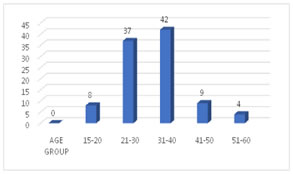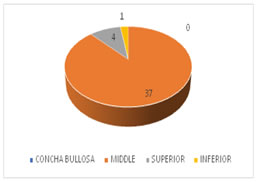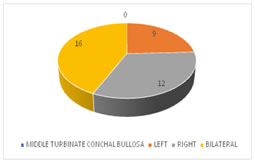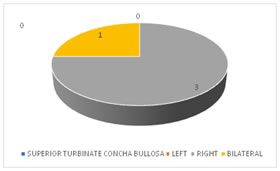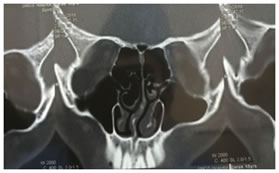Official Journals By StatPerson Publication
|
Table of Content - Volume 11 Issue 1 - July 2019
Relationship between concha bullosa and deviated nasal septum: A hospital-based study
Aditiya Saraf1, Deep Jyoti2*
1,2Department of ENT and Head and Neck Surgery, SMGS Hospital, Government Medical College, Jammu, Jammu & Kashmir, INDIA. Email: rksaraf56@gmail.com
Abstract Aims and Objectives: to study correlation between presence of concha bullosa and direction of nasal septal deviation. Material and Methods: A total of 100 patients within age group of 18-60 years with sino nasal complaints were analysed in our study and were subjected to NCCT nose and paranasal sinuses- axial and coronal cuts. Scans were reviewed for any nasal cavity and paranasal sinus abnormality, with special focus on presence of concha bullosa and deviated septa. Results: Upon correlating concha bullosa and deviated nasal septum, it was found that out of 15 cases of right sided concha bullosa (including all three turbinates), 13 cases had left sided deviated nasal septum, 1 had right sided deviated nasal septum and 1 did not have any nasal septal deviation. Out of 10 cases of left sided concha bullosa (including all three turbinates), 9 had right sided deviated nasal septum and 1 did not have any nasal septal deviation. Conclusion: It can be concluded as per our study that there is a strong relationship between concha bullosa and contralateral nasal septal deviation Key Word: Concha, Deviation, NCCT
INTRODUCTION Aeration of the middle turbinate / concha bullosa is a common anatomical variant of intranasal anatomy. Concha bullosa is the cystic end of the middle nasal concha. Concha exists on all sides of the nasal cavity. The middle turbinate may be pneumatised by the spread of the ethmoid air cells- in which case it will be considered a concha bullosa. The incidence of middle turbinate pneumatisation or concha bullosa has been well described in literature. Most often, bone pneumatisation is located in the middle nasal turbinate and can occur either unilaterally or bilaterally. Air filled cavity in the superior turbinate can be present less frequently, whereas the aeration of inferior turbinate is hardly observed3. In most cases, a pneumatic chamber remains asymptomatic. There is a classification of pneumatisation of concha bullosa based on its location- lamellar, bulbous and extensive.1 Moreover the type of epithelium in an air-filled concha bullosa is the same as in rest of sinonasal tract.2 Nasal septal deviation is described as an asymmetry of nasal septum. Both traumatic deviation and growth associated abnormalities of nasal septum may lead to significant airway obstruction and also, cosmetic deformity3. The aim of our study was to study correlation between the presence of concha bullosa and direction of nasal septal deviation.
MATERIAL AND METHODS The present study was conducted in Department of ENT and Head and Neck Surgery, SMGS Hospital, GMC Jammu from Feb 2018 to March 2019. A total of 100 patients within age group of 18-60 years with sino nasal complaints were analysed in our study and were subjected to NCCT nose and paranasal sinuses- axial and coronal cuts. Scans were reviewed for any nasal cavity and paranasal sinus abnormality, with special focus on presence of concha bullosa and deviated septa. Concha bullosa was defined as the presence of pneumatisation of any size within superior, middle or inferior conchae. Direction of nasal septal deviation was described by the convexity of septal curvature; convexity was evaluated in relationship to the line between anterior nasal spine and crista galli observed in coronal plane4. The exclusion criteria of our study were- age below 18 years, previous history of sino-nasal surgery and tumor destroying sino-nasal anatomical landmarks RESULTS The age distribution of patients revelead majority in age group of 31-40 years (42%), with mean age being 35.4 years. Out of 100 patients, 56 were females and 44 were males.
Out of 100 patients, 37 showed middle turbinate concha bullosa, 4 showed superior turbinate pneumatisation and 1 showed inferior turbinate pneumatisation.
Out of 4 patients of superior turbinate concha bullosa (4%)- 3 showed right conchal pneumatisation and 1 showed bilateral pneumatisation 1 patient of inferior turbinate concha bullosa showed bilateral conchal pneumatisation. Out of 100 patients, 35 patients showed left sided nasal septal deviation and 32 showed right sided nasal septal deviation.
Upon correlating concha bullosa and deviated nasal septum, it was found that out of 15 cases of right sided concha bullosa (including all three turbinates), 13 cases had left sided deviated nasal septum, 1 had right sided deviated nasal septum and 1 did not have any nasal septal deviation. Out of 10 cases of left sided concha bullosa (including all three turbinates), 9 had right sided deviated nasal septum and 1 did not have any nasal septal deviation.
DISCUSSION In our study, Out of 100 patients, 37 showed middle turbinate concha bullosa, 4 showed superior turbinate pneumatisation and 1 showed inferior turbinate pneumatisation. Out of 37 patients of middle turbinate concha bullosa (37%)-9 showed left conchal pneumatisation, 12 showed right conchal pneumatisation and 16 showed bilateral conchal pneumatisation. Out of 4 patients of superior turbinate concha bullosa (4%)- 3 showed right conchal pneumatisation and 1 showed bilateral pneumatisation. 1 patient of inferior turbinate concha bullosa showed bilateral conchal pneumatisation. Out of 100 patients, 35 patients showed left sided nasal septal deviation and 32 showed right sided nasal septal deviation. Upon correlating concha bullosa and deviated nasal septum, it was found that out of 16 cases of right sided concha bullosa (including all three turbinates), 14 cases had left sided deviated nasal septum, 1 had right sided deviated nasal septum and 1 did not have any nasal septal deviation. Out of 11 cases of left sided concha bullosa (including all three turbinates), 10 had right sided deviated nasal septum and 1 did not have any nasal septal deviation.
CONCLUSION
REFERENCES
|
|
||||||||||||||||||||||||||||
 Home
Home
